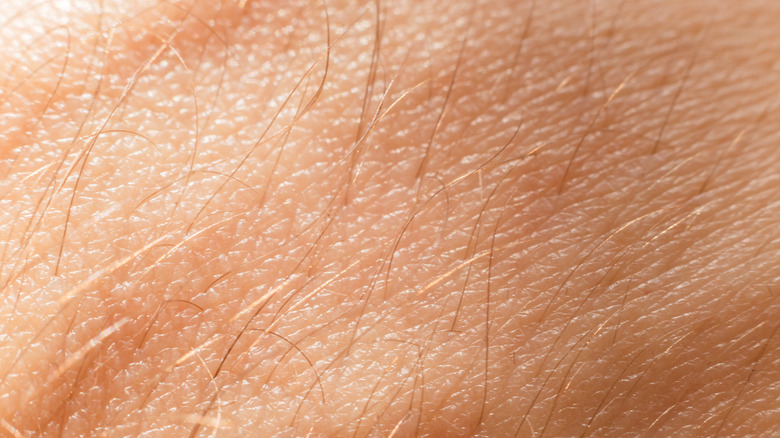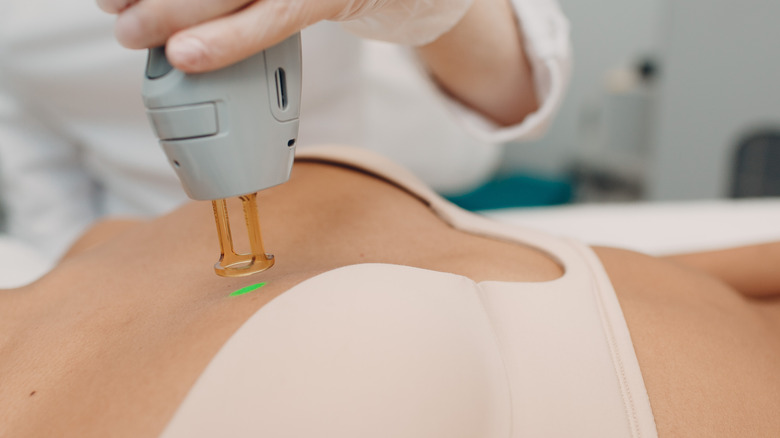Feeling Self-Conscious About Your Nipple Hair? Here's Why You Really Shouldn't
When it comes to body parts, nipples are usually the least of our concern. It's probably because they only get to see the light of day when it's time for breastfeeding or erotic stimulation. Although we rarely find ourselves feeling awkward about the look of our nipples, this mainly tends to happen when we wake up to find hair sprouting in the area. If you're noticing hair all over your nipple, do not panic! Nipple hair is far more common than you might think and we are starting to collectively dismantle the idea that it's a bad thing. Just look at celebrities like Lily Allen, who are unapologetic about their body (including nipple) hair (via Metro)!
Nipple hair is not a life-threatening or rare condition, so it's totally up to you whether you want to remove it or not. It's understandable if you do feel self-conscious about it, or get frightened by the prospect of having people pose questions or make jokes when they see it, since we've been conditioned to find hair on the female body repulsive. But social conditioning is far from a reflection of real facts, and you don't have to feel self-conscious. To help you understand your body better, we've compiled all the key facts concerning nipple hair and why you shouldn't feel embarrassed about it.
Nipple hair comes with age
The growth of hair around the nipple area is the common and healthy effect of fluctuations in sex hormones. "It is especially common around the times we go through hormonal changes, such as pregnancy and menopause," Dr. Claudia Pastides tells Cosmopolitan. Nipple hair can also develop on teenagers as they go through puberty.
It doesn't take much for your hormones to fluctuate. For example, hormones such as melatonin, cortisol, and prolactin, are subject to the circadian and sleep-wake cycles and fluctuate throughout the day, according to a 2010 study published in the International Journal of Endocrinology. The way your hair grows on certain parts of your body can change over time and there's no predicting or stopping it. It's part of the natural process of aging and many women will experience it — men will, too, only society isn't so worried about that!
An increase in sex hormones called androgens when puberty hits might lead to the growth of darker, coarser hair, per Health.com. During pregnancy, many women have accelerated hair growth in areas such as the nipples or the belly due to a spike in both estrogen and testosterone levels. Later, the levels of female hormones plummet in menopausal women, giving way to a boost in the male sex hormones that trigger more hair growth.
Nipple hair can be a symptom of a medical condition
In some cases, hair growth around the nipples can be a symptom of excessive testosterone production, where a woman's body generates too much testosterone and not enough estrogen to compensate for it, per MedicalNewsToday. Hirsutism (the abnormal growth of dark hair in women) as a result of polycystic ovaries, and congenital adrenal hyperplasia, are the most prevalent reasons for increased testosterone levels in women.
Certain medical treatments, such as testosterone and glucocorticoids, can also cause unwanted hair growth in women. For instance, nipple hair growth has been linked to Cushing's syndrome, a condition that develops when your body produces too much of the stress hormone cortisol over time. This syndrome is a common side effect of the long-term use of glucocorticoids.
Nipple hair only becomes a cause for concern when it grows all over the place or if it's accompanied by other symptoms. If that's the case, you should get your breast checked by a dermatologist or a gynecologist to get an accurate diagnosis. But if your nipple hair is growing sparingly, there's no need to do anything about it.
Nipple hair might run in the family
Hirsutism, which can be responsible for excessively hairy nipples, can run in the family. If you've been noticing thick dark hair growth on your chest or other parts of your body and your other family members are going through the same thing, there's a chance it's part of your ancestry. Those who are of Hispanic, Mediterranean, Middle Eastern, or South Asian heritage are statistically more prone to developing hirsutism, and over 40% of females experience the condition in general, according to Cleveland Clinic. To find out if this is what you're dealing with, you can go for a hirsutism check or a genetic test.
If your nipple hair is genetic, there's nothing you could have done to prevent it. You can either believe that your genes are stacked against you or you can choose to embrace it as part of who you are. If it's any consolation, the world has indeed come a long way in becoming receptive to women growing body and facial hair. The Januhairy campaign, for example, started by then-university student Laura Jackson, encourages women to grow out their body hair as a way of fully accepting themselves (via Instagram).
At the end of the day, nobody can tell you to go hairy or go hairless. You should take full ownership of your body and decide what you want to do with it.
How to get rid of nipple hair
Nipple hair is normal, safe, and extremely common, but it's still okay if you want to get rid of it. You can manually remove your nipple hair by plucking it with a clean tweezer and numb the pain by placing an ice pack over it. If your nipple hair is thick, you can try waxing it to remove the hair at the roots. Unless you have a steady hand and all the right tools, it's advisable that you have it done in a salon by a professional.
More advanced and costly hair removal methods — like electrolysis and IPL laser treatments — can help you get rid of your nipple hair and prevent regrowth over the long-term. However, if you have a low pain threshold or darker hair with paler skin, laser hair removal might be a better option than electrolysis. "Keep in mind that depending on the practitioner, electrolysis has a risk of scarring. I prefer laser hair removal," dermatologist Dr. Janet Prystowsky tells Bustle. According to Satori Laser, hair removal around a hormonal area like the nipples might require six to 12 sessions to achieve 75% to 95% improvement with each session spaced out five to eight weeks apart. The treatment might be longer for those suffering from hormonal imbalances.
Wrapping up, nipple hair is nothing to be embarrassed about and not even worth a trip to the doctor if you have a few sprouts of hair around the area. However, if you're noticing rapid growth coupled with abnormal symptoms, you should get your breast checked out by a professional.




